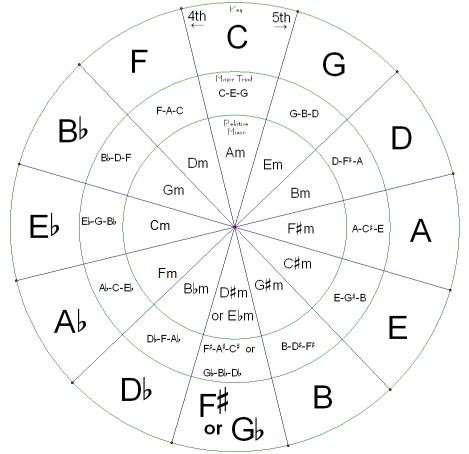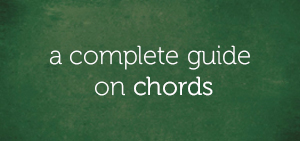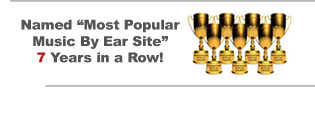 Ok, so you’ve probably heard terms like “2-5-1 chord progression,” “2-5-1 progression,” or just “2-5-1” for short.
Ok, so you’ve probably heard terms like “2-5-1 chord progression,” “2-5-1 progression,” or just “2-5-1” for short.
These are just ways to describe chords going from one to the other… simple!
Here’s a little poem I made up.
Notes create scales,
scales create chords,
chords create progressions,
progressions create songs.
I know, I know… it doesn’t rhyme but it explains music in 4 lines.
Basically, what it’s saying is the 12 unique tones on the piano create organized scales (there’s 12 of them, too, for every tone of the piano).
These scales define “major keys.” When you hear someone singing, they HAVE to be singing in one of these 12 keys.
If they are like some of the rejects on early American Idol episodes, they may be in two major keys, wavering from one to the other without knowing it (…that’s why they are rejects). At any given time, though, you can only be in one key… if the singer is legit.
Once you know scales, there are easy formulas to play chords. I’ve made tons of prior posts on chords.
While scales are tones played one after the other, chords are three or more tones sounded at the same time.
One leads to the next as chord progressions are basically a series of chords going from one to the other… basically what you hear when you’re listening to your favorite band. You’re hearing chords organized into progressions.
And that’s what this post talks about… the third line in my little poem:
Notes create scales,
scales create chords,
chords create progressions,
progressions create songs.
So where do the numbers come from?
Good question.
They actually come from scales.
Every scale can be thought of in terms of numbers.
Like this, a “C major” scale:
C D E F G A B C
If you want to be really good at understanding all 12 keys (so that you’re not one of those musicians who can only play in one key), then you’ll want to think of this same scale in terms of numbers:
C D E F G A B C
1 2 3 4 5 6 7
Not only do these numbers let you create chords immediately (“scales create chords”), but they also allow you to play progressions pretty easily.
First, the chords.
If you want to play a major chord, here’s the formula:
1 + 3 + 5
Bam! Easy! You don’t have to know all that deep theory or even about intervals to create chords from scales. You just need to know the formula. Take any 1st tone, 3rd tone, and 5th tone — and play them together and there’s your major chord.
In C major, for example, the 1, 3, and 5 are “C,” “E,” and “G.” Just play them together and that’s a C major chord. (All I did was take the 1st, 3rd, and the 5th tones of the C major scale above and play them together… it’s that simple!)
The good news is that there are easy formulas like that for just about every type of chord, but that’s not what I want to talk about. I want to talk about progressions.
“2-5-1”
Basically, the “2” is the second tone of the scale. The “5” is the fifth tone of the scale. And the “1” is ________________ (well, you know the rest).
But the only difference is, unlike the chords where you would take the 2, 5, and 1 — and play them together… this time, you’re actually forming separate chords on each one of those tones and leading from one to the other.
So some kind of chord built on the second tone of the scale “PROGRESSES” to some type of chord built on the 5th tone of the scale, which ends by progressing to some type of chord that’s built on the 1st tone of the scale.
That’s how progressions work.
Now, I could get deeper but I won’t. There’s plenty of lessons on the chords that go with every tone of the scale. But just know this… every tone has a “favorite” chord that usually goes with it.
The first tone is usually a major chord. It CAN be something different but usually it’s some kind of major chord (I say “some kind” because you can have a very basic major chord all the way up to a fancy “major 13” chord).
The second tone of the scale is usually a minor chord. So that “2” in the “2-5-1” is usually minor.
The fifth tone of the scale is usually a major chord as well. Now, as we get more fancy, it can also be a dominant chord but let’s keep it simple.
So we have a major chord on the 1st tone, a minor chord on the 2nd tone, and a major chord on the 5th tone.
That means our 2-5-1 looks something like this:
2minor > 5major > 1major
You get that?
So now… because we’re dealing with numbers (the universal language), we can apply this chord progression to any key.
If we want to play this in C major, we just figure out the 2nd, 5th, and 1st tone of C major and we’re ready to fill in the gaps:
C D E F G A B C
1 2 3 4 5 6 7
The 2nd tone is: ___________
The 5th tone is: ___________
The 1st tone is: ___________
Therefore, the 2-5-1 progression in C major is:
___minor > ___major > ___major
You should have:
Dminor > Gmajor > Cmajor
Putting it all together
Ok, so how can I get really good at playing in all 12 keys without even having to think about it? How can I just play that same 2-5-1 chord progression in any key I want? Whether C major, or F major or Ab major… how can I get to that level Jermaine?
Good questions…
The answer is…
MASTERING THE NUMBERS.
See, the chord part is easy. If you know the “2” will always have a minor chord, the “5” will always have a major chord, and the “1” will always have a major chord, then all you have to know is all 12 major and minor chords and you’re good to go.
The hard part is knowing what the 2 of Ab major is without even having to think about it. Or the 5 of B major without blinking an eye. Or the 1 of C major (…now you have to be pretty slow not to know the “1” because the “1” is the first tone of the scale… in other words the title of the scale you’re playing… hehe). C major scale… the 1 is “C,” which is in the title.
So with that said, your biggest battles are going to be knowing the “2s” and “5s” of every key.
The best thing to do is to follow this circle of fifths pattern below, calling out the 2 of every key as you move clockwise (or counter-clockwise) around the circle.
I personally like to move counter-clockwise because that is the direction music moves in. In fact, moving counter-clockwise gives you a 2-5-1 chord progression. Check out this chart below:

Notice that C is at the top (12 o clock). And if you move to where 11 o clock would be, which is F, and then move again to Bb… and stop for a moment to think about it, you’ll notice that “C > F > Bb” is a “2-5-1” in the key of Bb major.
So every 3 neighboring notes on the circle of fifths chart going counter-clockwise is a 2-5-1 in the last key of the group.
(If you study the circle of fifths, you’ll be blown away at how much there is to learn from this simple little circle.)
But that’s a lesson in and of itself.
Here’s the exercise I want you to do though:
1) First you’ll start off by trying to master your “2s” of every key.
2) Starting at C, call out the “2nd” tone of C as fast as you can.
3) You can either go clockwise or counter-clockwise. If you go my direction (counter-clockwise), then the next key will be F. Call out the 2nd tone of F as fast as you can.
4) Proceed to do this around the entire circle.
5) Use a stopwatch to figure out how long it took you to call out the “2s” of all 12 keys. If you don’t have one, check out my online stopwatch tool.
Then start all over and do the same thing for the “5s” of every key.
To be honest, you should be doing it for every tone of the scale. You should be doing it for 2 thru 7. Don’t worry about doing it for the 1st tone of the scale as you have to be pretty slow not to know that C is the first tone of the C major scale, lol.
So that’s how you get good at knowing what a “2-5-1” is in the key of “B” without thinking about it. It comes down to knowing the numbers.
But you don’t have to be a math whiz! You just have to be committed to knowing your keys and doing these exercises will have you on your way!
If you’re really serious, check out my home study course. It covers this kind of stuff in depth.
Use the comment form below to talk back to me. If you reading this post via e-mail or rss reader, click on to the site to leave a comment below.
How long did it take you to call out your “2s” and “5s” in each key?
What do you find most challenging about mastering each key?
Do you like to go clockwise around the circle or counter-clockwise?
Hate numbers? lol
Like this lesson? Hate this lesson?
See ya next time!







Comments on this entry are closed.